How to Make the Most of Visiting Zion in November
November in Zion: Are you thinking of visiting Zion National Park in November? November is one of the best months to visit Zion as there are far fewer crowds and the weather in Zion in November is very pleasant.

Zion National Park is one of the most gorgeous sites in the United States, and when you mix in the stunning autumn colors, it’s a sight to behold.
November is one of the best months to visit Zion National Park. Autumn colors are a spectacular sight woods turn a brilliant yellow, and there are pockets of maple trees that turn an enticing red.
The biggest advantage of visiting Zion in November is that the crowds have mostly disappeared, allowing for some peace and quiet in the park.
Beautiful blue skies and awe-inspiring red, orange, and yellow cottonwoods line the banks of the Virgin River in November, providing incredible chances for sunrise and sunset photography. Nothing beats the contrast of autumn-colored foliage against red and white sandstone cliffs.
Begin as soon as possible. Visitors who come early in the morning may have a better chance of seeing wildlife. Furthermore, the park is significantly less congested, as most visitors to Zion arrive around mid-morning.
If at all possible, avoid weekends and visit Zion National Park during the late fall on weekdays. Please note that the Zion shuttle system operates from November.
Thank you for supporting this website written by an American. This post may contain affiliate links. This means I earn a small commission on these links at no extra cost to you.
National Park Entrance Fees
To enter the National Parks, you’ll need to pay an entrance fee or have a National Parks Pass also known as American the Beautiful Pass.
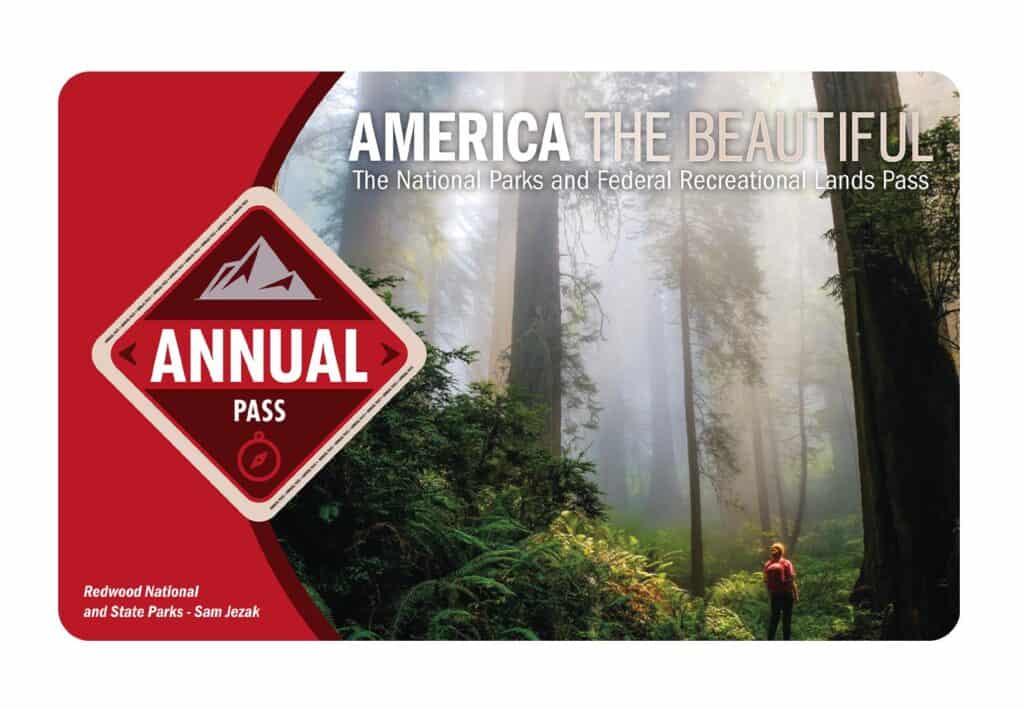
It costs $80 for a yearly America the Beautiful Pass. This gives you access to all national parks and federal areas that charge fees. The America the Beautiful Pass is well worth it!
I purchased my first one in 2016 and it’s such a money-saver! Plus 10% of sale proceeds go to the National Park Foundation.
Tips for Visiting Grand Teton National Park
Grand Canyon National Park is perfect for outdoor enthusiasts. There is something for everyone on this list and for different fitness levels. Also, note that it is dry and hot (in the summer), and make sure you know what you are getting into before you start. Here are a few tips for visiting the Grand Canyon:
- Bring a reusable water bottle and lots of water! Remember you are in the sun and you will need to drink lots of water. I love my LifeStraw Filtered Water Bottle. I can refill this bottle anywhere and it comes with a carabiner to connect it to my daypack.
- Check the Weather – days over 100 degrees are very common. Make sure to check.
- Hiking boots or sandals that will protect your feet! I love good shoes. I need all the support and help I can get. I actually love these sandals for hiking and also love these hiking boots.
- Bring hiking poles for balance and to protect your knees. I know many experienced hikers (and even amateur ones) think that hiking poles are for old people who lose their balance. Actually, hiking poles can help when going down steep inclines or when scrambling over rocks. They are great to hike with even for the most experienced hiker.
- Wear a sunhat. I feel like this whole post is about how high you are in the mountains and how much closer you are to the sun but it is so true. At elevation, you are closer to the sun and more likely to burn. Wear sun protection such as a sun hat and sunscreen.
- Be aware of the wildlife. This is the Southwest and you will need to watch out for snakes and other wildlife such as moose or a bear. Please stay away from wildlife and do not feed them. I recommend carrying bear spray as well.
- Start Early – If you want to avoid the traffic and the heat you will need to start your hike early. That way it will be nice and cool and the smog will not affect you either.
- Leave no trace. If you are new to the concept of Leave No Trace it is all about preserving the environment to ensure it is in the same or better condition when you leave it. This means that you should stick to the trails and carry out everything that you carried in. This is a great explanation of the Leave No Trace principles!
- Water shoes are great for water hikes– If you don’t have a pair, I highly suggest it as they are affordable. I have an article on the pros and cons of several pairs of water shoes.
- Bring Bug Spray and a snack: Be sure to bring everything you need including a snack like a protein bar plus BUG SPRAY.
Where to stay near Grand Canyon National Park
The Grand Canyon makes for a great weekend escape. Fresh air, beautiful scenery and being in nature does a world of good for the soul. I recommend staying as close to the park as possible and even treating yourself with a cabin with a spa pool to relax at night.
- There are lots of fantastic Airbnbs near the Grand Canyon. I have made a list of the best airbnbs around the park wherever you decide to stay. You can also check out my post on Where to Stay near the Grand Canyon to find the perfect hotel for any budget.
If you are taking a road trip remember to reserve a car in advance using Discover Cars .
National Park Entrance Fees
To enter the National Parks, you’ll need to pay an entrance fee or have a National Parks Pass also known as American the Beautiful Pass.

It costs $80 for a yearly America the Beautiful Pass. This gives you access to all national parks and federal areas that charge fees. The America the Beautiful Pass is well worth it!
I purchased my first one in 2016 and it’s such a money-saver! Plus 10% of sale proceeds go to the National Park Foundation.
Tips for Visiting Grand Teton National Park
Grand Canyon National Park is perfect for outdoor enthusiasts. There is something for everyone on this list and for different fitness levels. Also, note that it is dry and hot (in the summer), and make sure you know what you are getting into before you start. Here are a few tips for visiting the Grand Canyon:
- Bring a reusable water bottle and lots of water! Remember you are in the sun and you will need to drink lots of water. I love my LifeStraw Filtered Water Bottle. I can refill this bottle anywhere and it comes with a carabiner to connect it to my daypack.
- Check the Weather – days over 100 degrees are very common. Make sure to check.
- Hiking boots or sandals that will protect your feet! I love good shoes. I need all the support and help I can get. I actually love these sandals for hiking and also love these hiking boots.
- Bring hiking poles for balance and to protect your knees. I know many experienced hikers (and even amateur ones) think that hiking poles are for old people who lose their balance. Actually, hiking poles can help when going down steep inclines or when scrambling over rocks. They are great to hike with even for the most experienced hiker.
- Wear a sunhat. I feel like this whole post is about how high you are in the mountains and how much closer you are to the sun but it is so true. At elevation, you are closer to the sun and more likely to burn. Wear sun protection such as a sun hat and sunscreen.
- Be aware of the wildlife. This is the Southwest and you will need to watch out for snakes and other wildlife such as moose or a bear. Please stay away from wildlife and do not feed them. I recommend carrying bear spray as well.
- Start Early – If you want to avoid the traffic and the heat you will need to start your hike early. That way it will be nice and cool and the smog will not affect you either.
- Leave no trace. If you are new to the concept of Leave No Trace it is all about preserving the environment to ensure it is in the same or better condition when you leave it. This means that you should stick to the trails and carry out everything that you carried in. This is a great explanation of the Leave No Trace principles!
- Water shoes are great for water hikes– If you don’t have a pair, I highly suggest it as they are affordable. I have an article on the pros and cons of several pairs of water shoes.
- Bring Bug Spray and a snack: Be sure to bring everything you need including a snack like a protein bar plus BUG SPRAY.
Where to stay near Grand Canyon National Park
The Grand Canyon makes for a great weekend escape. Fresh air, beautiful scenery and being in nature does a world of good for the soul. I recommend staying as close to the park as possible and even treating yourself with a cabin with a spa pool to relax at night.
- There are lots of fantastic Airbnbs near the Grand Canyon. I have made a list of the best airbnbs around the park wherever you decide to stay. You can also check out my post on Where to Stay near the Grand Canyon to find the perfect hotel for any budget.
If you are taking a road trip remember to reserve a car in advance using Discover Cars .
Zion National Park in November Weather
The weather in Zion National Park in November is cool during the day and chilly at night. The average temperature in Zion Canyon is 63 degrees Fahrenheit (17 degrees Celsius) with a low of 37 degrees Fahrenheit (17 degrees Celsius).
The average temperature in Kolob Canyons is 58 degrees Fahrenheit (14 degrees Celsius), with a high of 58 and a low of 33 degrees Fahrenheit (14 degrees Celsius). During November, it rains on average 5 days. Before leaving for the day, check the weather forecast for Zion National Park.
Tips for Visiting in Zion National Park
Zion is perfect for outdoor enthusiasts. There is something for everyone on this list and for different fitness levels. Also, note that it is dry and hot (in the summer), and make sure you know what you are getting into before you start. Here are a few tips for visiting Zion:
- Bring a reusable water bottle and lots of water! Remember you are in the sun and you will need to drink lots of water. I love my LifeStraw Filtered Water Bottle. I can refill this bottle anywhere and it comes with a carabiner to connect it to my daypack.
- Check the Weather – days over 100 degrees are very common. Make sure to check.
- Hiking boots or sandals that will protect your feet! I love good shoes. I need all the support and help I can get. I actually love these sandals for hiking and also love these hiking boots.
- Bring hiking poles for balance and to protect your knees. I know many experienced hikers (and even amateur ones) think that hiking poles are for old people who lose their balance. Actually, hiking poles can help when going down steep inclines or when scrambling over rocks. They are great to hike with even for the most experienced hiker.
- Wear a sunhat. I feel like this whole post is about how high you are in the mountains and how much closer you are to the sun but it is so true. At elevation, you are closer to the sun and more likely to burn. Wear sun protection such as a sun hat and sunscreen.
- Be aware of the wildlife. This is the Southwest and you will need to watch out for snakes and other wildlife such as moose or a bear. Please stay away from wildlife and do not feed them. I recommend carrying bear spray as well.
- Start Early – If you want to avoid the traffic and the heat you will need to start your hike early. That way it will be nice and cool and the smog will not affect you either.
- Leave no trace. If you are new to the concept of Leave No Trace it is all about preserving the environment to ensure it is in the same or better condition when you leave it. This means that you should stick to the trails and carry out everything that you carried in. This is a great explanation of the Leave No Trace principles!
- Water shoes are great for water hikes– If you don’t have a pair, I highly suggest it as they are affordable. I have an article on the pros and cons of several pairs of water shoes.
- Bring Bug Spray and a snack: Be sure to bring everything you need including a snack like a protein bar plus BUG SPRAY.
Things to do in Zion National Park in November
Zion Canyon Scenic Drive
Three of the four Zion National Park scenic routes are open to visitors in the fall. During a rainstorm in November, you might observe pop-up waterfalls, which is cool!
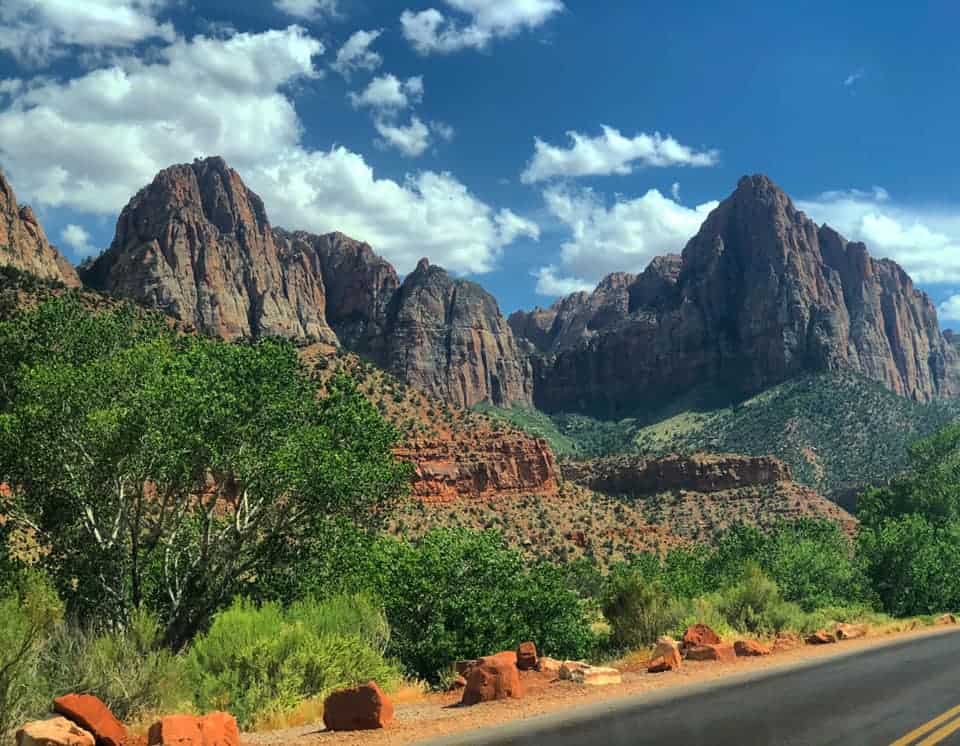
The shuttle is the only way to get to Zion Canyon Road. It’s an astonishing 6.5 miles of breathtaking rock formations and hiking routes.
A must-drive is the Zion-Mt. Carmel Highway and Tunnel! The tunnel is 1.1 miles long and gains 800 feet in elevation. The drive from Zion Canyon to the east entrance of Zion National Park is also magnificent. Take advantage of the pullouts to take pictures or go for a hike.
You can also drive the Kolob Canyons area of the park if you don’t mind going 40 miles north of Zion Canyon.
Temple of Sinawava
The huge amphitheater that unofficially marks the entrance of the canyon is the Temple of Sinawava, yet a stroll down the Riverside Walk will reveal that the canyon begins considerably further upstream.

It’s easy to see why the temple has become one of the park’s most visited attractions. As the temple comes into view, sheer rusty red and chocolate brown rocks climb into the sky like some of the world’s tallest skyscrapers, looking never-ending.
Zion provides shuttles to get to the Temple in Sinawava, which helps to alleviate traffic congestion. The temple is the last stop on the Zion Canyon Scenic Drive’s shuttle system. Shuttles have bike racks and can be boarded at any point along their route. The South Entrance’s parking plaza is the most popular boarding location.
Extensive hanging gardens of lush green foliage and beautifully colored flowers dangle from various levels and crevices, making it look almost too good to be real. It’s unmistakably postcard material.
Big Bend
Big Bend, in Zion National Park, is a stunning turn of the Virgin River that displays the Great White Throne to the south.
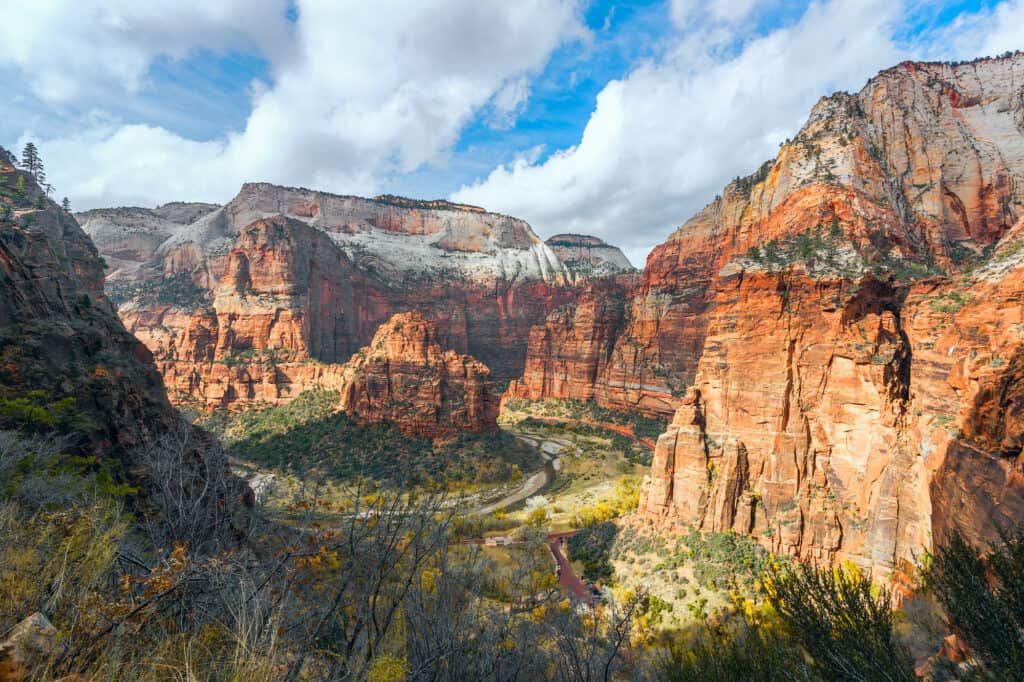
The Zion Shuttle stops here, and travelers can go down to the river to take in the breathtaking scenery. The cottonwoods’ leaves turn brilliant colors in the autumn, creating a stunning spectacle along the river. Condors soar over you from this vantage point.
This isn’t exactly a hike, but it is a nice spot to explore and play by the river. It’s the Big Bend shuttle stop, and it’s the shuttle’s second-to-last stop. Wild turkeys can often be seen scurrying around. Along the river, there is a trail that you can follow. This trail can be followed to the shuttle stop at Weeping Rock, or perhaps further.
If you’re bored of crowds, this is a great thing to do.
Riverside Walk
A must-do is the Riverside Walk, which starts at the Temple of Sinawava, the last shuttle stop. The path is paved and mostly flat. You’ll wind your way along the Virgin River, with opportunities to get off the paved path and closer to the river.
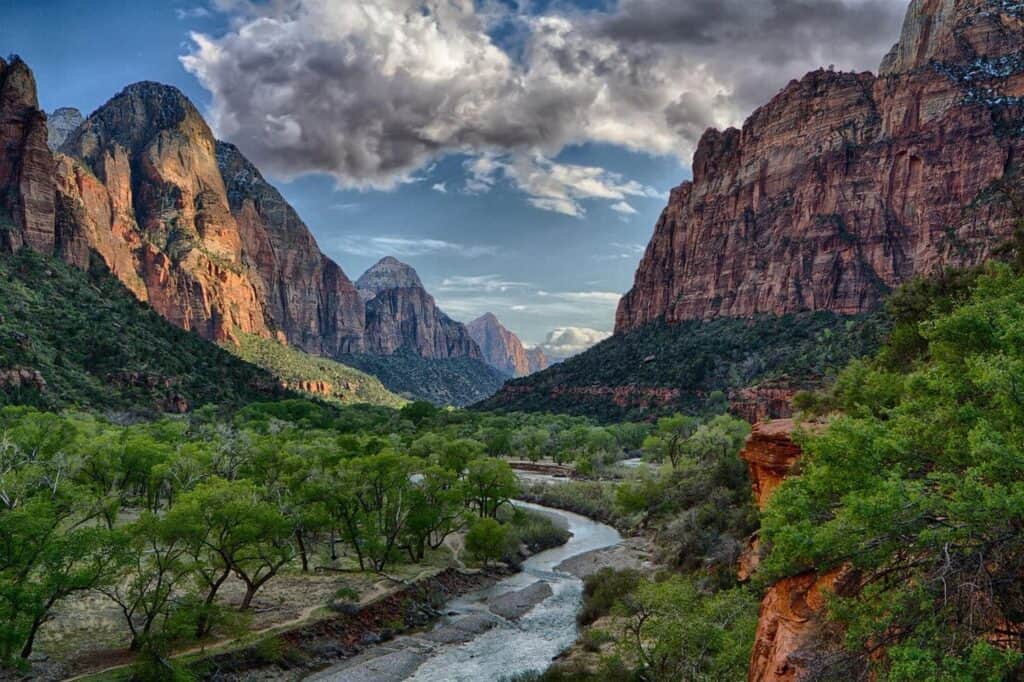
The 2.2-kilometer round-trip stroll is suitable for people of all ages and abilities. The tranquil walk through the trees with the mountains on either side of the river allows you to take in your surroundings at a leisurely pace.
Since the Riverside Walk trail is paved, it is great for strollers and little children. When the leaves change color, this is a modest hiking track that becomes breathtakingly gorgeous. This region of Zion National Park will be filled with magnificent tones of golden and red flora and trees during the fall months.
The walk through the trees with the mountains on either side of the river is peaceful and lends itself to a relaxed pace as you take in your surroundings. It’s not as flashy as some of the other hikes in Zion, but the walk through the trees with the mountains on either side of the river is peaceful and lends itself to a relaxed pace as you take in your surroundings.
Weeping Rock
Weeping Rock is a popular tourist site and a well-known landmark in Zion National Park. A broad bowl-shaped alcove has formed as the lower layer of sandstone has eroded.
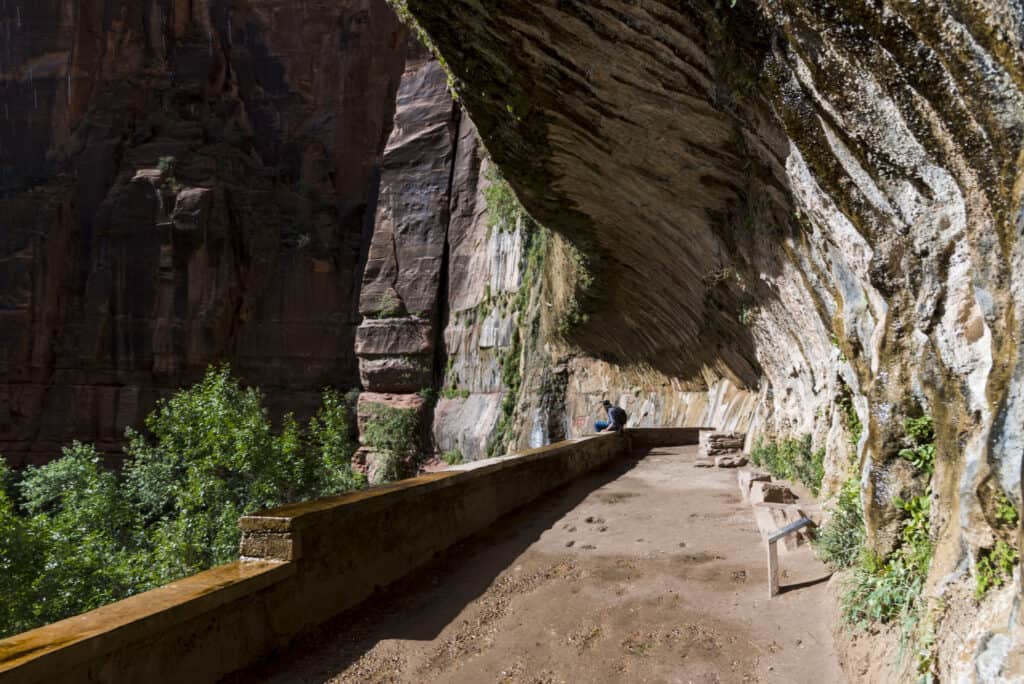
Weeping Rock is a short hike deep in Zion Canyon that leads to a spectacular natural structure with breathtaking views.
Water from Weeping Rock’s seeps and springs poured as rain and snow on the cliffs above more than 1,000 years ago: water that had been slowly descending through the sandstone formations reached an impermeable layer of rock and was forced out the side, resulting in the “weeping.”
Ancient rainwater has slowly poured down the cliffs since then, appearing at Weeping Rock to nourish rich vegetation and magnificent wildflowers.
It is positioned 100 feet above the canyon floor and offers breathtaking views. The overlook offers a panoramic view of major Zion peaks, including the Great White Throne and Angels Landing.
This is a fantastic quick simple hike in Zion if you don’t have a lot of time but yet want to get some exercise.
Pa’rus Trail
The Pa’rus Trail is one of Zion National Park’s newest and most accessible trails. It’s the park’s only bike and pet-friendly trail, as well as one of the few wheelchair-friendly trails. The trail is also flat enough that you can proceed at your own pace, depending on who is in close vicinity to you.
Throughout the hike, the scenery is breathtaking, with multiple bridges crossing the river, various wildflowers, and mule deer frequently observed.
The Pa’rus Trail is wonderful for bird watching—or simply reclining under the shade of a magnificent cottonwood tree—due to the sheer thick flora along the Virgin River’s banks.
A noteworthy feature is a historic diversion dam that was used to cut off water to Springdale. Near the northern terminus of Route 9, the route passes and ends at the Canyon Junction shuttle stop.
Emerald Pools Trail
The Emerald Pools Trail is excellent if you’re seeking fantastic hikes in Zion. It’s a well-known route that resembles a desert oasis. This trail is made up of multiple smaller trails that snake their way through a lovely landscape. Arrive early because this is one of the most popular Zion family hikes.
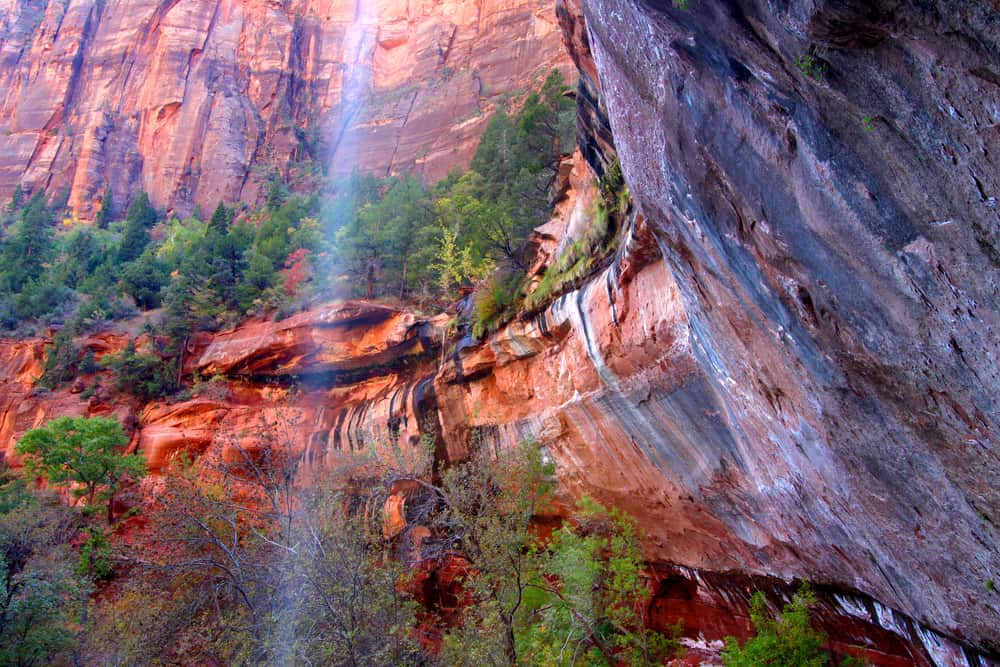
Lower Emerald Pool, has a weeping wall and pools at the bottom. A paved walk leads to the location, which begins at the Zion Lodge shuttle bus stop #5. Near the Zion Lodge, the trail leads to a lushly vegetated stream. If you only have a couple of hours in Zion with your family, there is no better spot to spend it.
In less than half a mile, the trail enters a steep alcove beneath two tall waterfalls and the pools below, where the forest thickens and the trail winds through a steep alcove beneath two tall waterfalls and the pools below. This will be accessible to even the elderly and those with strollers.
Spend some time photographing one of Zion National Park’s well-known short hikes.
Angel’s Landing
You may see a view of the canyon from 1,500 feet above the canyon floor if you hike to the summit of Angel’s Landing.
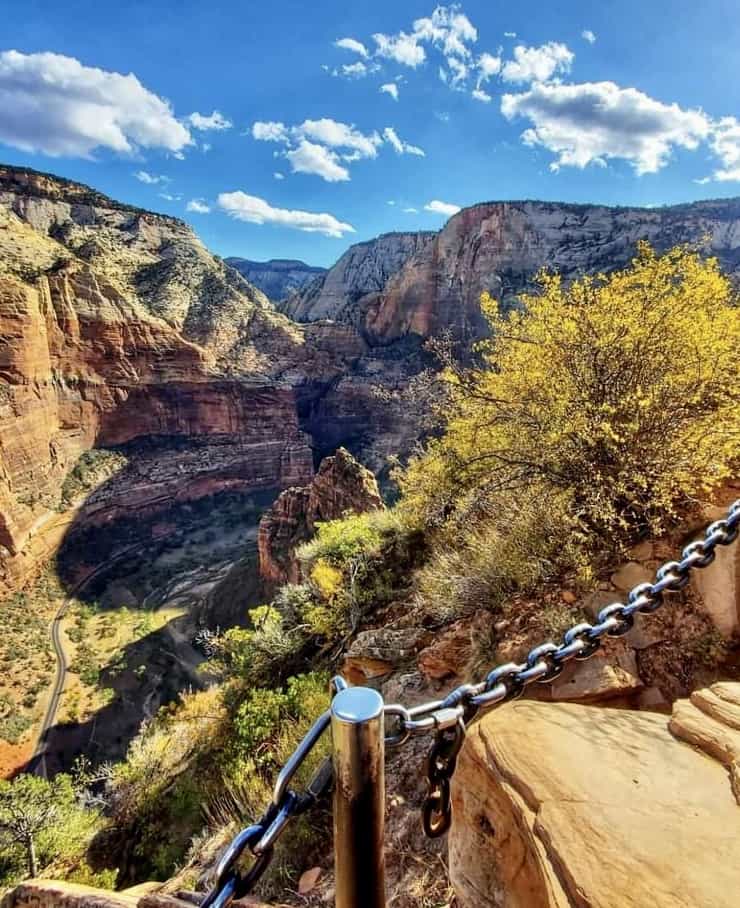
The climb exposes hikers to precipitous drop-offs of up to 1,500 feet, with the narrowest section of the trail measuring about 3 feet in width. It’s definitely a trail for people with steely nerves.
Stopping at Scout’s Lookout is an “alternative” to hiking to the top. This is the point on the trail where the switchbacks finish and the trail continues down Angel’s Landing’s spine. Scout’s Lookout still provides a spectacular perspective of the canyon, but not as spectacular as the summit.
This hike in Zion National Park begins at the Grotto and continues along the West Rim Trail until you reach Refrigerator Canyon. Once within the canyon, you’ll begin climbing Walter’s Wiggles, a series of famous switchbacks. You can either stop at Scout’s Lookout or go on to the top of Angel’s Landing after completing the switchbacks.
Hidden Canyon Trail
At Hidden Valley, you get a completely different – and rarely photographed – view of Angel’s Landing, Cable Mountain, and The Great White Throne. This is a great path which is tucked away off one of the park’s busiest paths.

The canyon itself is a narrow slot with water-filled pools, hidden arches, and massive boulders. It’s one of the park’s most beautiful places, and the hike there is similar to Angel’s Landing.
As though you’re going to Observation Point, you’ll begin this Zion National Park hike at the Weeping Rock trailhead. When you reach the top of Big Bend and the start of the East Rim Trail, however, you’ll take a much less-traveled side trail that leads to Hidden Canyon.
It’s at this point that the real fun begins. After passing through the Hidden Canyon turnoff, you’ll climb 1,000 feet up steep switchbacks with plenty of spectacular drop-offs. Climbers are protected by chains embedded in the rock.
Watchman Trail
The Watchman Trail (about 3 miles round-trip) begins between the Visitor Center and the South Campground and leads to a viewpoint on top of the first tier of cliffs, roughly 300 feet above the canyon floor.
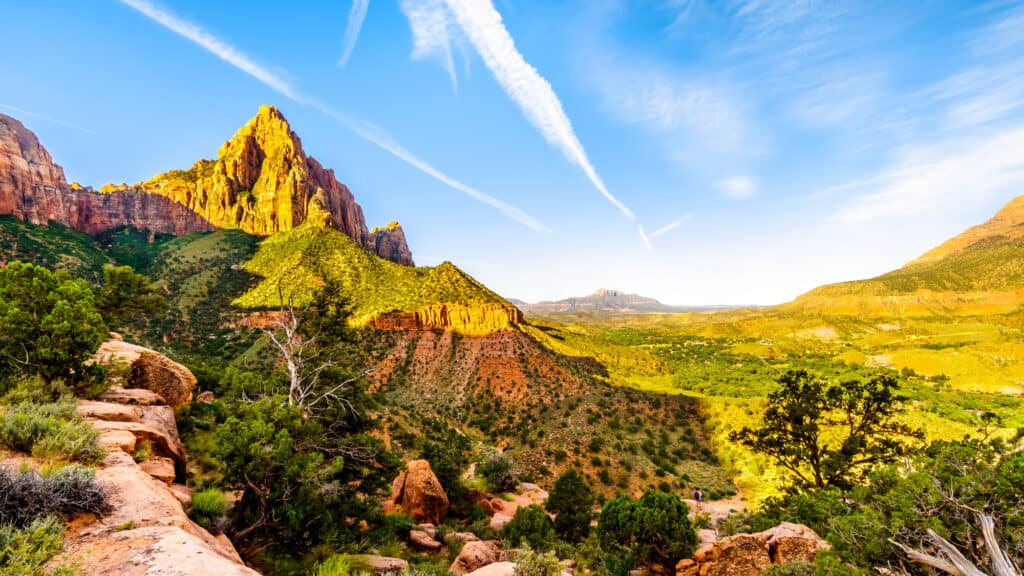
Although the trail is largely family-friendly, keep a watch on children because there are a few cliff edges to be aware of. This trail is entirely exposed to the sun, therefore it’s better to take it on an overcast day or early in the morning while this side of the main canyon is still in the shade.
The trail begins in the vicinity of the Zion Visitor Center. Simply walk the road towards Route 9 and look for the trailhead sign on the north side of the road, on the Virgin River’s east bank. The trail begins ordinarily, skirting the river’s banks before heading behind some employee residences and building materials. The track becomes moderately strenuous for the next mile, ascending and circling a tiny valley until you reach the first tier of cliffs above the main canyon.
While the trail does not lead to the summit of Watchman Mountain, it does provide a good view of the famous and photogenic peak to the south, as well as a bird’s eye view of the entire Visitor Center complex below.
Zion Ponderosa
Enjoy all of the activities that the 4,000-acre Zion Ponderosa Ranch Resort has to offer, including a climbing wall, miniature golf, trampoline bungee, zip line, basketball, billiards and foosball, horseshoes, ping pong, tennis, pool, hot tub, and volleyball. The restaurants at Zion Ponderosa Ranch have everything you’re looking for in a dining experience.
You’ll be close to Zion National Park and Zion Canyon, of course. Horseback riding, Jeep tours, rafting, and hiking are just a few of the activities available to you and your family and friends while vacationing in these Zion National Park cabins.
Utah’s first national park is a spectacular display of red and tan-colored Navajo sandstone located at the junction of the Great Basin, the Colorado Plateau, and the Mojave Desert regions. With elevations ranging from 3,666 to 8,726, the park’s natural canyons, buttes, mesas, mountains, and arches will leave you speechless.
The Park is divided into four climate zones: desert, riparian, woodland, and coniferous forest, and it is home to an incredible amount of bird, mammal, and reptile species.
Recent Posts
15 Tips for Visiting the Grand Canyon in September – 2023 Ultimate Guide
Visiting the Grand Canyon in September is a great time to visit. September is a busy time to visit but the crowds are starting to arrive especially toward the end of the month. I’ve included...
15 Tips for Visiting the Grand Canyon in August – 2023 Ultimate Guide
Visiting the Grand Canyon in August is a great time to visit. August is a busy time to visit but the crowds are starting to arrive especially toward the end of the month. I’ve included all...
